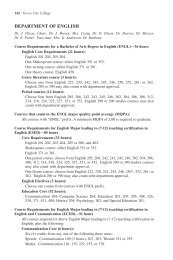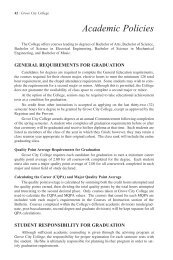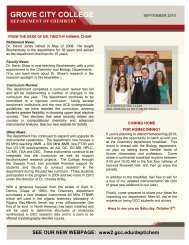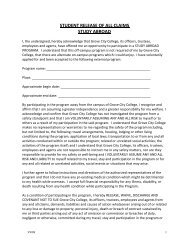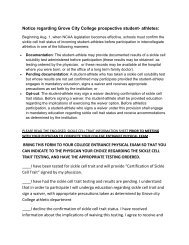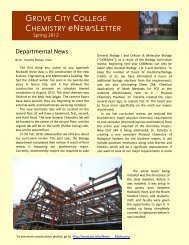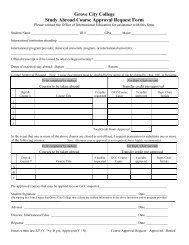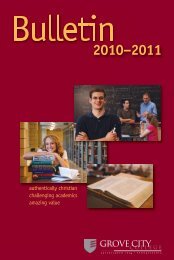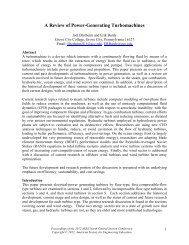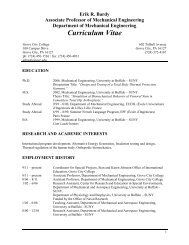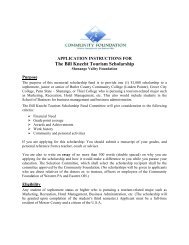2009–2010 - Grove City College
2009–2010 - Grove City College
2009–2010 - Grove City College
You also want an ePaper? Increase the reach of your titles
YUMPU automatically turns print PDFs into web optimized ePapers that Google loves.
94 / <strong>Grove</strong> <strong>City</strong> <strong>College</strong><br />
CHEM 302. TECHNIQUES IN CHEMISTRY LABORATORY INSTRUCTION. A course limited<br />
to junior or senior Chemistry Secondary Education and General Science Secondary Education<br />
majors involving instruction and experience in setting up and conducting effective educational chemistry<br />
demonstrations and laboratories. This course fulfills the Writing Intensive (WI), Speaking<br />
Intensive (SI), and Information Literacy (IL) requirements for Chemistry Education majors.<br />
Prerequisite: Chemistry 227 and 241. Spring semester only, one hour.<br />
CHEM 345. PHYSICAL CHEMISTRY I. An introduction to the principles of quantum mechanics<br />
and their application in describing molecular properties. An emphasis is placed on developing a solid<br />
understanding of the principles of spectroscopy. Three lectures and one lab per week. Prerequisites:<br />
Chemistry 102 or 105 and Chemistry 264. Fall Semester, four hours.<br />
CHEM 346. PHYSICAL CHEMISTRY II. Thermodynamics, Statistical Mechanics, and Kinetics.<br />
The relationships between the properties of macroscopic systems are developed to gain an understanding<br />
of chemical equilibrium. The principles of statistical mechanics are introduced to show how<br />
thermodynamic properties can be predicted from molecular properties described by quantum mechanics.<br />
Connections are developed between chemical kinetics and reaction mechanisms. Three lectures<br />
and one lab per week. Students may not receive credit for both Chemistry 346 and Physics<br />
340. Prerequisites: Chemistry 102 or 105 and Chemistry 264. Spring Semester, four hours.<br />
CHEM 351. BIOCHEMISTRY I. A study of the structure-function relationships of biochemical<br />
compounds of living systems. This course concentrates on the major pathways of human metabolism.<br />
Three lectures and one lab per week. Prerequisite: Chemistry 242. Fall Semester, four hours.<br />
CHEM 352. BIOCHEMISTRY II. A study of biochemical compounds and their interactions. This<br />
course will center specifically on the structure and functional relationships of DNA, RNA and proteins.<br />
Three lectures and one lab per week. Prerequisite: Chemistry 242. Spring Semester, four hours.<br />
CHEM 356. MOLECULAR SYMMETRY AND GROUP THEORY. An introduction to the chemical<br />
applications of group theory. The relationship between the symmetry of molecules and their physical<br />
and chemical properties will be emphasized. One lecture per week. Prerequisite: Chemistry 241.<br />
Spring semester only, one hour.<br />
CHEM 360. INDEPENDENT STUDY. Individual study of specialized topics in Chemistry. Junior<br />
standing and permission of the department chair and a faculty sponsor are required.<br />
Semester course, one, two or three hours.<br />
CHEM 370. INDEPENDENT CHEMISTRY RESEARCH. Juniors who have displayed aptitude<br />
in chemistry perform assigned research problems. This course may not be taken concurrently with<br />
Chemistry 499. Three hours of laboratory work per week per credit hour. Prerequisite: an application<br />
must be submitted and approved by department. Semester course, one or two hours.<br />
CHEM 390. STUDIES IN CHEMISTRY. This course is used to present various advanced topics in<br />
chemistry. Semester course, one to three hours.<br />
CHEM 406. INSTRUMENTAL ANALYSIS. A course focused on instrumental theory and design,<br />
and the application of instruments in the analytical process and analysis of complex samples. Two lectures<br />
and one lab per week. Prerequisite: Chemistry 227, 252, and 346.<br />
Spring semester only, three hours.<br />
CHEM 425. INORGANIC CHEMISTRY. This course emphasizes the role that symmetry plays in<br />
chemical structure and bonding theory with descriptive chemistry interwoven to illustrate theoretical<br />
concepts. The periodic table is studied in sufficient detail for the student to become aware of the many<br />
important trends that form the basis of its organization. Three lectures per week. Prerequisite:<br />
Chemistry 242, 252, and 356. Fall semester only, three hours.<br />
CHEM 428. ORGANOMETALLIC CHEMISTRY. A study of the synthesis and properties of<br />
organometallic compounds and their role in modern catalytic processes. The rapidly growing areas of<br />
bioinorganic and bioorganometallic chemistry is discussed. Three lectures per week. Prerequisite:<br />
Chemistry 425. Spring semester only, three hours.



